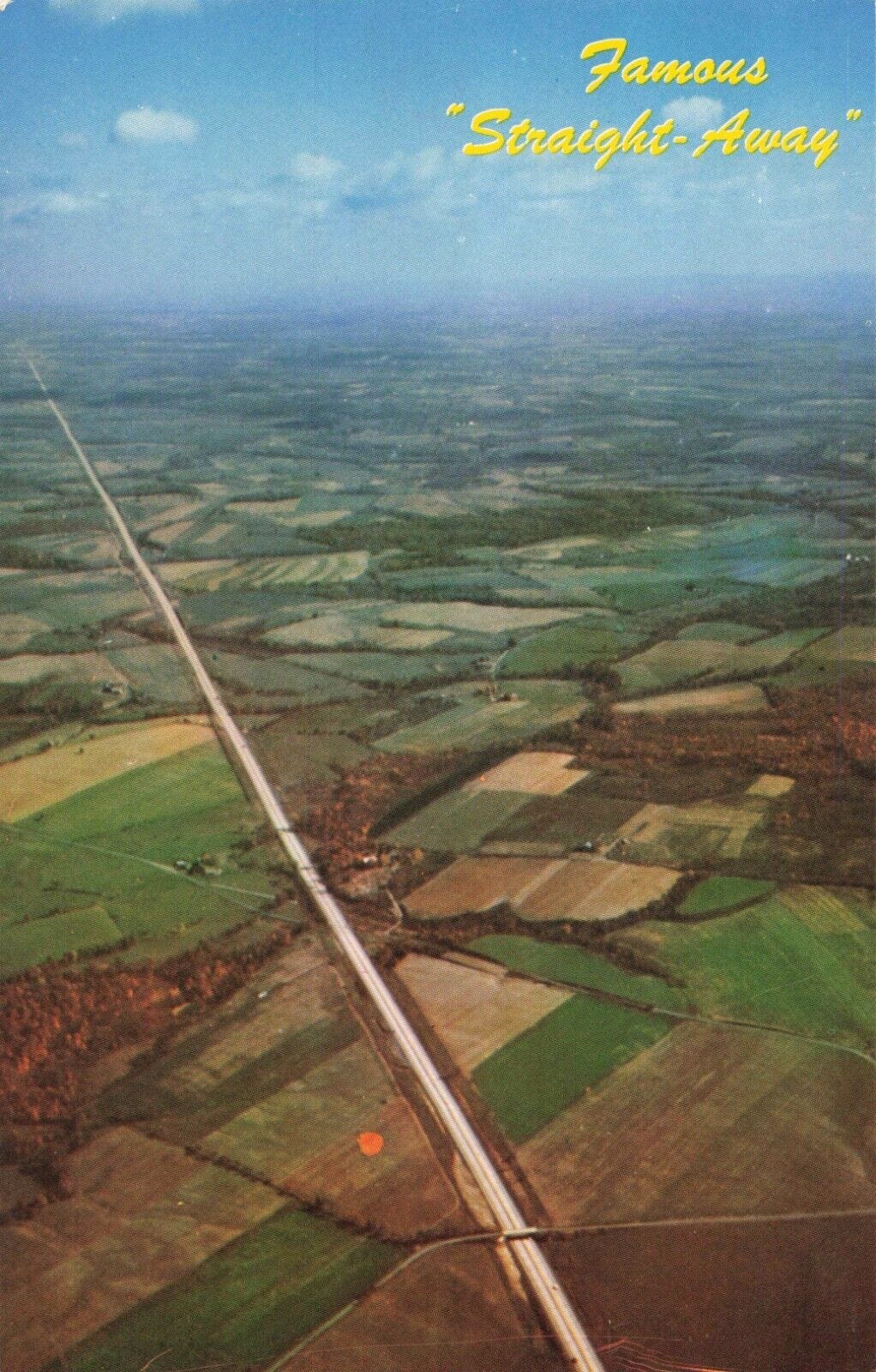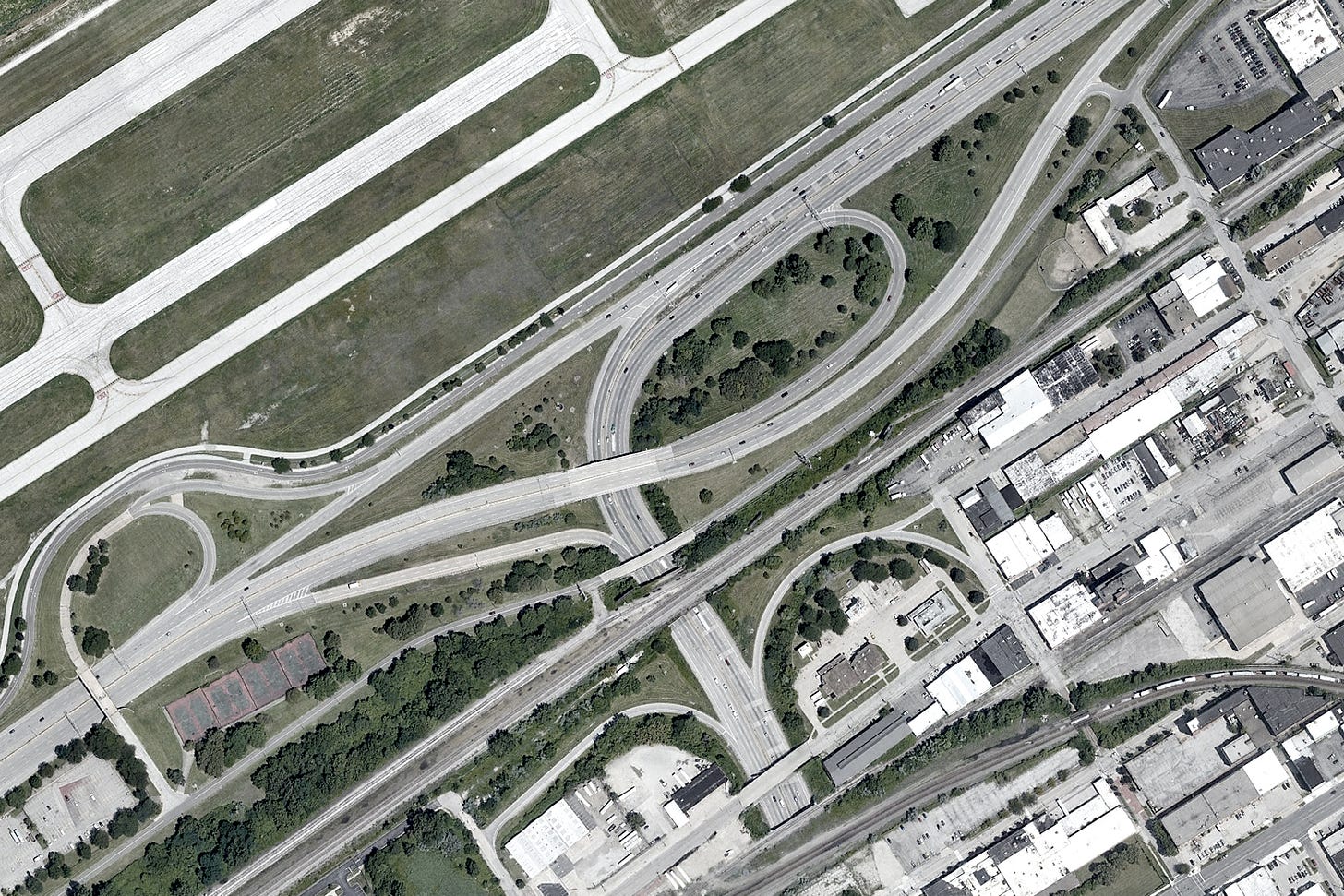1,400 words, a seven-minute read
There is an astonishingly sharp turn on an interstate in Ohio that brings me great joy. It’s pretty dangerous, and will one day be straightened at great expense. This is probably a good idea. But, it would be a shame if this unique feature of our vast American roadway system isn’t at least celebrated in some way via, say, a Substack essay. So, here we go.1
See, every year around Christmas time, my wife and I drive from Massachusetts to Iowa and back. The most exciting infrastructural feature on the trip by far is the Interbelt Curve. Built in 1959, it’s a tight 90-degree turn on I-90 in downtown Cleveland. Locals call it Dead Man’s Curve.2 Abbreviated “DMC”, here on the ‘stack.
The driver-seat experience of DMC can be described like this:
I-90 typically has a 70 mph speed limit in rural Ohio, but this decreases to 65 and then 55 in urban Cleveland. The first warning that an unusual road condition is coming up is a pair of large yellow signs that read “35 MPH CURVE AHEAD”. Soon after is another sign, this one sporting what is assuredly the biggest (and longest) 90-degree arrow known to mankind. Then the rumble strips begin, the first two slower and evenly spaced but quickly it’s an unsettling rumble accelerando, like:
“Buuuuuuuuuuuuurp.”
“Buuuuuuuuuuuuurp.”
“Buuuuuuurp. Buuuuuuurp. Buuuuuuurp.”
“Buuuurp. Buuuurp. Buuuurp. Buuuurp.”
“BURP BURP BURP BURP BURP BURP BURP BURP BURP.”
“RP RP RP RP RP RPR PR PR PR PR RP RP RP RP RP RP RP RP”3
In the final staccato of burps, the turn itself begins and the sign offensive resumes, this time with an accompaniment of spastically flashing lights. It’s a whole body experience now, a kaleidoscope of U.S.A.-freeway paraphernalia twisting into infinity. Mid-curve, a millisecond glimpse of lake Eerie gets thrown into the mix, unexpectedly disturbing in its horizontal, cerulean stability. None of this lakeside juxtaposition will register with DMC’s rookie travelers, who usually realize just-in-time that the 35 mph sign, perhaps unlike road signs previously encountered, is not simply a conservatively underestimated speed limit.
Everyday, tens of thousands of vehicles (mine included, thank you for your concern) make it through DMC without any D’ing. Still, there’s a lot of physical evidence of many a mishap on the side of the concrete barriers, especially on the west-bound starboard flank. Warning measures aside, of course it isn’t the safest condition, and indeed the Ohio Department of Transportation (ODOT) reports that the Interbelt has a crash rate two to three times the regional average for urban freeways.4
“You know” I am positive many a DMC driver remarks, Slurpee® in hand, whilst brushing aside dangling fuzzy dice that swing with the sideways g-forces, “something really ought to be done about this turn, it’s not safe! (Sluuuuuuuuuuuuuurp.)”
If our hypothetical beverage aficionado investigated the turn, he or she would be in luck. For other than traffic updates following (for example) an Amazon truck turnover5, the media’s focus on DMC generally falls into two categories.
First are the handful of local news articles explaining that the curve will be straightened one day.6 It’s worth pointing out that this will not be cheap, with the cost of easing the curve estimated to be around $500 million.7 According to Cleveland Magazine, ODOT official Amanda McFarland “admits that today’s engineering standards would never allow a turn to be built like this one and plans are in the works to eventually ease the severity of the angle.”8
Second is the “myth buster” category, which can basically be summed up by article headlines like this one: “Dead Man's Curve: Is the terrifyingly named turn really that dangerous?”9 10 The answer is basically: “kind of”. Serious accidents were more frequent in the 60’s, 70’s and 80’s, prior to the aforementioned rumble strips and other safety retrofits. Fatalities are rarer these days, although unfortunately a near 20-year streak without any ended with a deadly crash in the summer of 2021.11 Non-fatal accidents are not uncommon, with ODOT reporting 150 injuries on the curve between 2009 to 2019.12 Nevertheless, Cleveland Magazine reported the “Myth” of Dead Man’s Curve as “Busted” in a 2019 article.13
So summarizes the mainstream media’s main takeaways about DMC. To recap:
DMC will one day be smoothed out, and it will cost a fortune.
Dead Man’s Curve is perhaps an overly dramatic moniker given the relative infrequency of fatal accidents in recent decades.
Personally, I find these points to be fair but ho-hum, and they leave me with a deep wanting for deeper meaning. Allow me to elaborate by first introducing DMC’s alter roadway: the Pennsylvania Turnpike Straightaway. I will do this by paraphrasing a very real conversation I once heard:14
G*** S******: What state do you hit if you go due west from Pittsburg?
J*** W*****: Ohio!
G*** S******: No! West Virginia!!15
(Audible gasps)
G*** S******: And has anyone driven east from Pittsburg?
S*****: Yes
G*** S******: Good!
S*****: I think I know what you’re going to say.
G*** S******: GOOD! You reach the Pennsylvania Turnpike Straightaway driving east on I-76, and it’s one of the longest straight-line sections of roads in the country. And driving on it…is very strange.
S*****: It’s weird.
G*** S******: Good!
S*****: It’s really weird.
G*** S******: GOOD! It’s weird because it was built before the Interstate Highway System was planned, when curves were introduced to otherwise straight roads to prevent highway hypnosis…this’s what Walter Miles wrote about in his 1929 article, “Sleeping with the Eyes Open”, where research showed that motorists can be effectively asleep even while continuing to operate a vehicle.16

So characterizes our enlightened standards about highway geometry. Too straight, and we go unconscious. Too curved, and we’re a dead man under a confetti of Amazon boxes.
With increasing adoption of various roadway safety campaigns by state and local transportation departments, it’s reasonable to assume that idiosyncratic roadway conditions are evermore likely to be on the chopping block for reengineering. Consider one well-known roadway safety non-profit, Vision Zero, whose thesis has been uncannily uttered by high-profile officials almost verbatim in multiple, separate instances.17 (Emphasis mine.)
In Boston:
Mayor Walsh announced that the City of Boston will adopt Vision Zero, based on the premise that traffic fatalities are not accidents, but rather they are crashes that can be prevented by effective policies and systematic evaluation, enforcement, engineering, education, and community engagement.18
And New York City:
…hence the City of New York would “no longer regard traffic crashes as mere ‘accidents’, but rather as preventable incidents that can be systematically addressed”19
And Rockville, Maryland:
Words matter. Deaths and serious injuries in traffic are not inevitable “accidents,” but preventable crashes that can be ended through engineering, enforcement and education.20
Indeed, it appears that somewhere behind Vision Zero’s multi-pronged activism and sleek infographics is a campaign to edify the masses with a new lexicon. “Accident” is out. “Crash” is in. But don’t just stop there. Take the pledge:
An eensy bit dogmatic, maybe? Either way, DMC’s days are limited, especially after Cleveland itself adopted a Vision Zero Action Plan in 2021.21
So be it. After all, what kind of monster wouldn’t support safer roads? Reader, I am not that monster. But there’s a piece of me that likes something about the curve. In part, I think it has something to do with one bullet point in the Vision Zero scripture that nags at the issue of roadway safety: the matter of driver behavior. That’s in there too, probably under the “education” umbrella of the aforementioned soundbites.
If a potpourri of flashing lights and signs and rumbles at jet-engine volume isn’t enough to demand focus and attention, what is? And anyway, the near-century old lesson embodied in the PA-Straightaway was that it’s the curve that keeps us from falling asleep.
Kept awake by the curve, we find aliveness, somewhere in a middle ground between death and hypnosis.
A younger me (three years ago, say) would very likely have written something pretty cringe here, like “so buckle up” or “so let’s go for a drive”. I think we can all be thankful I’ve matured greatly in my writing, at least with the sense to keep it with the appropriately unnoticeable “here we go.”
This is not the only Dead Man’s Curve. Turns out this is a recurring nickname for several sharp turns scattered across the U.S. (See the Wikipedia page on Dead Man’s Curve). The concept is also forever enshrined in Americana by Jan and Dean’s 1963 “Dead Man’s Curve”:
But I'll throw you one better if you've got the nerve
Let's race all the way
To Dead Man's Curve
This may not be an accurate diagram of the rumble strips but it’s an accurate depiction of memory of it. Memory is an active thing.
See report referenced here (along with some humorous user reviews about how the rumble strips sound like farts.)
Sweeny, Darren and Belle, Cris. July 21, 2022. “Lanes reopened at Dead Man’s Curve after semi crash”. Fox 8 Cleveland. (Link)
Consider that this is a noticeable fraction of the entire state of Ohio’s transportation budget at $8.3 billion over two years (according to Ohio Capital Journal), and that DMC is less than a mile, compared to Ohio’s 262,492 miles of roads.
Brill, Jason and Westfall, Ilona. November 25, 2019. “CLE Myths: Dead Man's Curve”. Cleveland Magazine. (Link)
Ibid.
See also No Author. November 14, 2014. “About Town: How deadly is Dead Man's Curve?” Cleveland Magazine. (Link)
WKYC Staff. August 27, 2021. “1 person killed in crash on Dead Man's Curve; lanes reopened on I-90, Route 2.” WKYC Studios. (Link)
Brill & Westfall
Ibid.
These are again artifacts of my memory and not the exact words of the speakers. The **** partly serve to anonymize them but also to fictionalize them, as they did not say it exactly like this anyway.
This is actually true, and you can look at a map to prove it. It still blows my mind every time I think about it. It’s also great for trivia or as a conversation starter at nerdy cocktail parties.
https://visionzeronetwork.org/
Article quoted, referencing: City of Boston. March 14, 2017. “MAYOR WALSH ANNOUNCES THE RELEASE OF THE CITY OF BOSTON'S VISION ZERO ACTION PLAN”. News. (Link)






Good to see you back to publishing, PinP! I first drove through Cleveland’s DMC way back in 1976. Back then it could maybe be excused as a ‘beginners mistake’ in the design of the fledgling interstate system. But still there nearly 50 years later?! It is a testament to the staying power of concrete, steel, and rights of way!